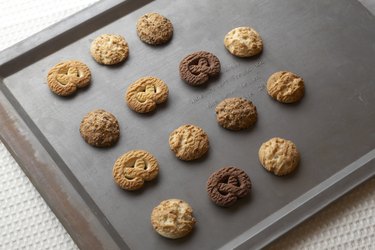
If you've been baking for a while, you know that a key ingredient in most recipes is baking powder or baking soda. Although it's possible to make banana bread without baking powder and cookies without baking soda, the result will be dense, unless you use some other leavening agent.
Tip
It is possible to make cookies without baking soda or baking powder, but the resulting cookie will be dense. This is because carbon dioxide is not being produced by a chemical reaction that typically occurs when baking soda or powder is present in the cookie batter.
Video of the Day
What Is Baking Powder?
If you're a regular baker, you know one ingredient that recurs in multiple baking recipes, like our Parsnip Morning Muffins, is baking powder. Baking powder, just like baking soda, is primarily made of sodium bicarbonate. However, where this substitute for baking soda differs is that it also contains two acids.
Video of the Day
According to North Carolina State University, it is monocalcium phosphate and either sodium acid pyrophosphate or sodium aluminum sulfate that make up the remainder of baking powder. They work together to delay the occurrence of an important chemical reaction until the dough is baked. When the sodium bicarbonate, a base, comes in contact with an acid like yogurt, a chemical reaction occurs that produces carbon dioxide.
This release of carbon dioxide causes the dough or batter to rise, resulting in baked muffins and cakes that are fluffy and airy. Using just baking soda, however, will result in the chemical reaction occurring in the mixing bowl and not in the oven, explains North Carolina State University_._ This is why baking powder is typically a better substitute for baking soda in most baking recipes.
Making Cookies Without Baking Soda
According to K-State Research and Extension, baking powders are often double-acting agents. The first step occurs when baking powder is added to the wet batter and releases carbon dioxide.
The second part occurs when the batter goes into the oven — the ideal temperature is over 170 degrees Fahrenheit — and the second acid present in the baking powder reacts with the remaining sodium bicarbonate to further release carbon dioxide. This can be seen in cakes or muffins rising in the oven, explains K-State Research and Extension.
Even if you use baking powder in your recipe, your dough may not always rise in the oven. According to Michigan State University Extension, this can occur when your leavening agent is past its expiration date. Moisture can also affect baking powder, weakening its effectiveness as a leavening agent in baking recipes.
It is possible to make cookies without baking soda and banana bread without baking powder. It's important to note that your batter or dough will not rise when baked in the oven, and the resulting treats will be dense and not airy.
Read more: Substitutes for Butter When Baking Cookies
Baking Powder Alternatives
There are a number of baking powder substitutes you can use if you run out of this pantry staple or if what you have on hand is old:
- Baker's yeast as a substitute for baking soda: Baking banana bread without baking powder can be done if you use yeast as a substitute for baking soda. When baker's yeast comes into contact with sugar present in the batter, a chemical reaction occurs, releasing carbon dioxide, and causes the dough to rise.
- Self-rising flour as a baking powder alternative: Made from a mixture of baking powder, flour and salt, self-rising flour can be used as a substitute for both flour and baking powder in specific baking recipes like biscuits. This results in a light biscuit with a fluffy interior.
- Cream of tartar as a baking powder substitute: K-State Research and Extension explains that cream of tartar is often used as a leavening agent that can be substituted for baking soda in baking recipes. When used with aquafaba (the liquid created when cooking beans with water) to make a plant-based meringue, cream of tartar helps the aquafaba mousse to maintain stiff peaks.
Read more: Adding Extra Yeast to Bread